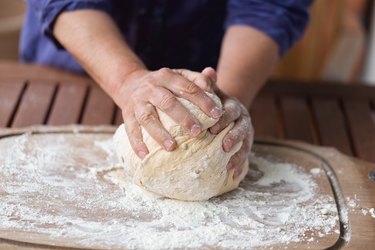
Too much yeast in bread may cause various problems. Follow your bread recipe closely, so you can have the pleasure of eating delicious homemade bread. Few edibles are as appetizing as this treat.
Whether there is too much yeast in pizza dough or too much yeast in dough to be used for other purposes, it can result in a disappointing end product. The effects may include an overly-large volume of bread, large holes in the bread or even a collapsed bread.
Video of the Day
Video of the Day
Tip
Adding extra yeast in bread can cause it to rise too much and produce large holes.
Too Much Yeast in Bread
The Home Baking Association provides the trouble-shooting information below to help bakers understand what may cause their bread to be less than perfect:
- Too much volume may be caused by too much yeast, too little salt, over proofing or a too-low an oven temperature.
- Too little volume may be due to chilled dough, too little yeast, too much salt or kneading too much or not enough.
- A dark-colored bread may stem from too much sugar, too much milk, a dough temperature that is too low or an oven temperature that is too high.
- A pale-colored bread may be caused by over-fermented dough, a lack of sugar or insufficient oven temperature.
- Large holes in bread may be due to too much yeast or too little salt.
- A heavy texture may stem from too little yeast, too little kneading, under mixing or a insufficient proofing temperature.
- Bread falling in the oven might be caused by over-proofing or an unheated oven.
- A collapsed loaf may be due to too much yeast, which causes over-rising, followed by collapsing.
Read more: Is Eating Yeast Bad for You?
Other Bread-Making Questions
Bakers commonly ask if too much sugar can kill yeast. The answer is yes, but indirectly. When yeasts are fed more sugar, they produce more alcohol. Because the yeasts aren't able to tolerate large amounts of alcohol, they can be killed.
Another frequent inquiry by aspiring bakers is how to activate or proof yeast. First of all, store dry yeast in the freezer. When you're ready to use it, put a package in a half cup of room-temperature or slightly-warm water. Don't use hot water because, it will kill the yeast. Add 1 teaspoon of sugar. After mixing, allow it to stand 5 to 10 minutes. Once it's bubbly, add it to your bread dough ingredients.
Bakers also ask how to use instant yeast, otherwise called fast-rising or fast-acting yeast. To use it, rehydrate the yeast in water with a little sugar, just as you would with non-instant yeast. You can substitute active dry yeast for instant yeast. Just use the same amount.
Use Whole Grain Flour
The Mayo Clinic recommends including more whole grains in the diet, because they're a great source of fiber and minerals. When making bread, substitute whole grain flour for at least part of the white flour. According to the Whole Grains Council, you can exchange half of the white flour for whole wheat flour without making any additional changes in a recipe for yeast bread.
Read More: Why Isn't White Bread Good for You?
If you'd like to make yeast bread solely out of whole wheat flour, mix in an extra 2 teaspoons of liquid for each cup of flour. Also, allow the dough to rest 25 minutes before you knead it.
Bread made with fresh whole wheat flour will have a sweeter taste than bread made with flour that has been in the pantry for an extended time. If you're unaccustomed to eating whole grains, start small, and slowly replace more white flour with whole wheat flour. To enhance the sweetness of the bread flavor, replace 2 to 3 tablespoons of the liquid in the recipe with orange juice, suggests the Whole Grains Council.